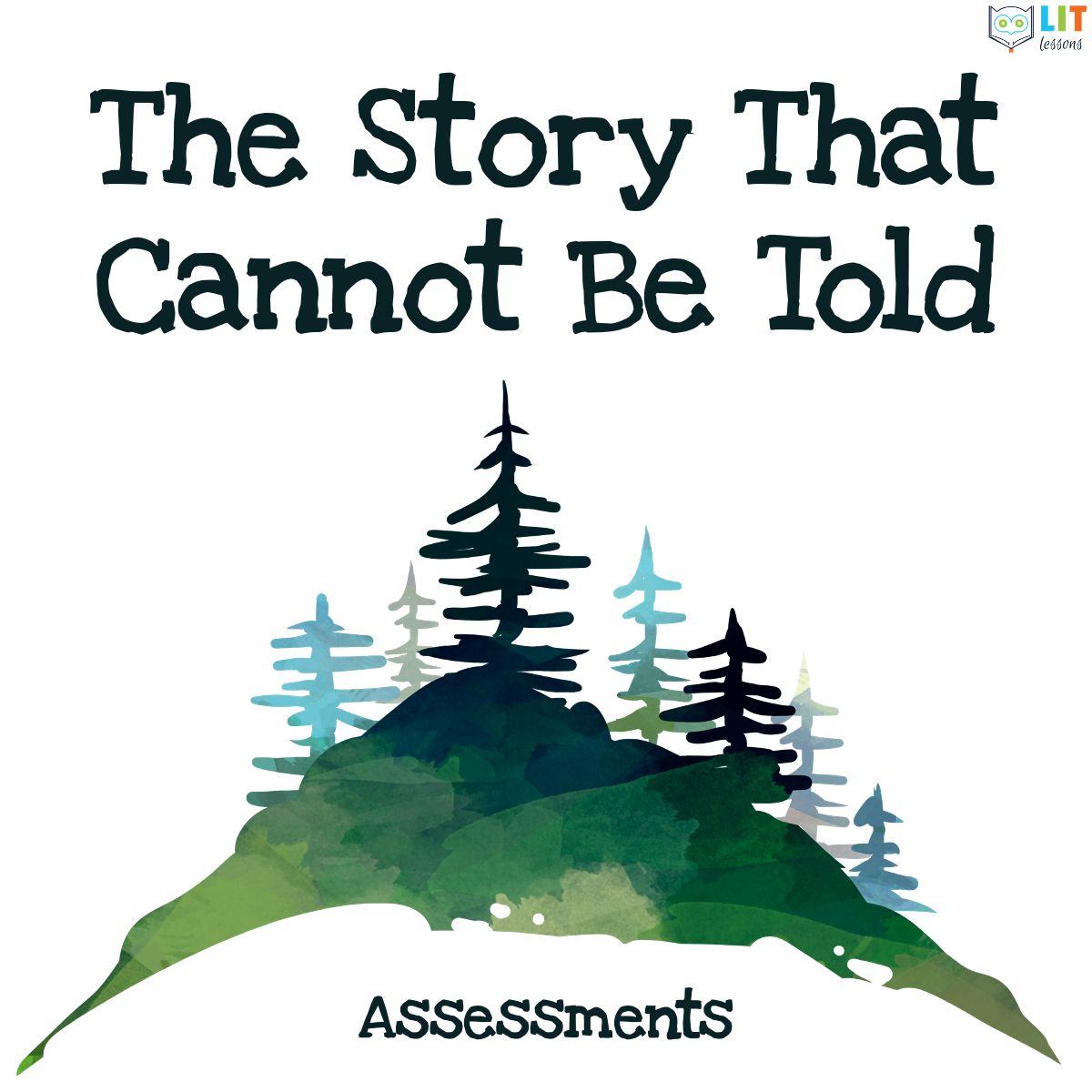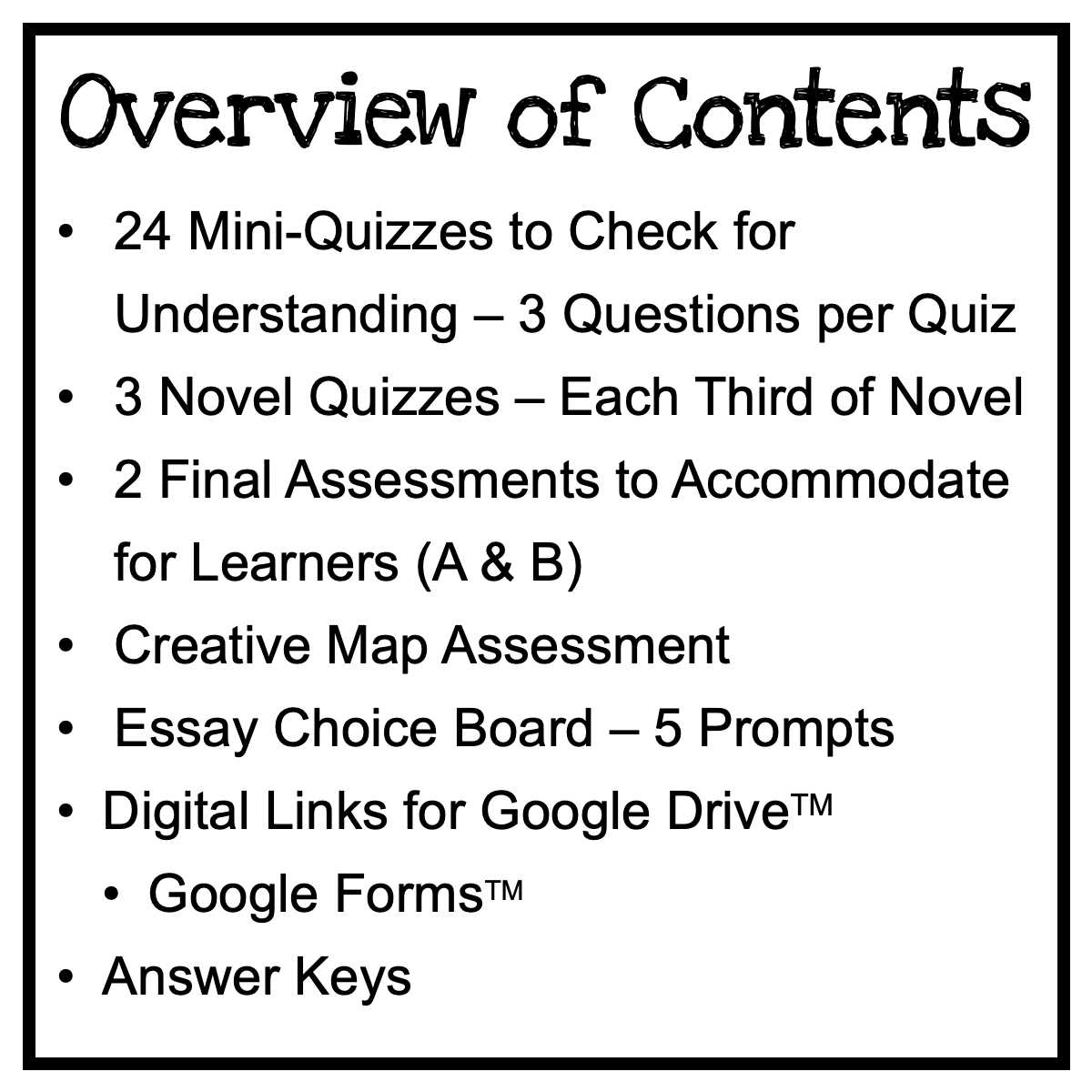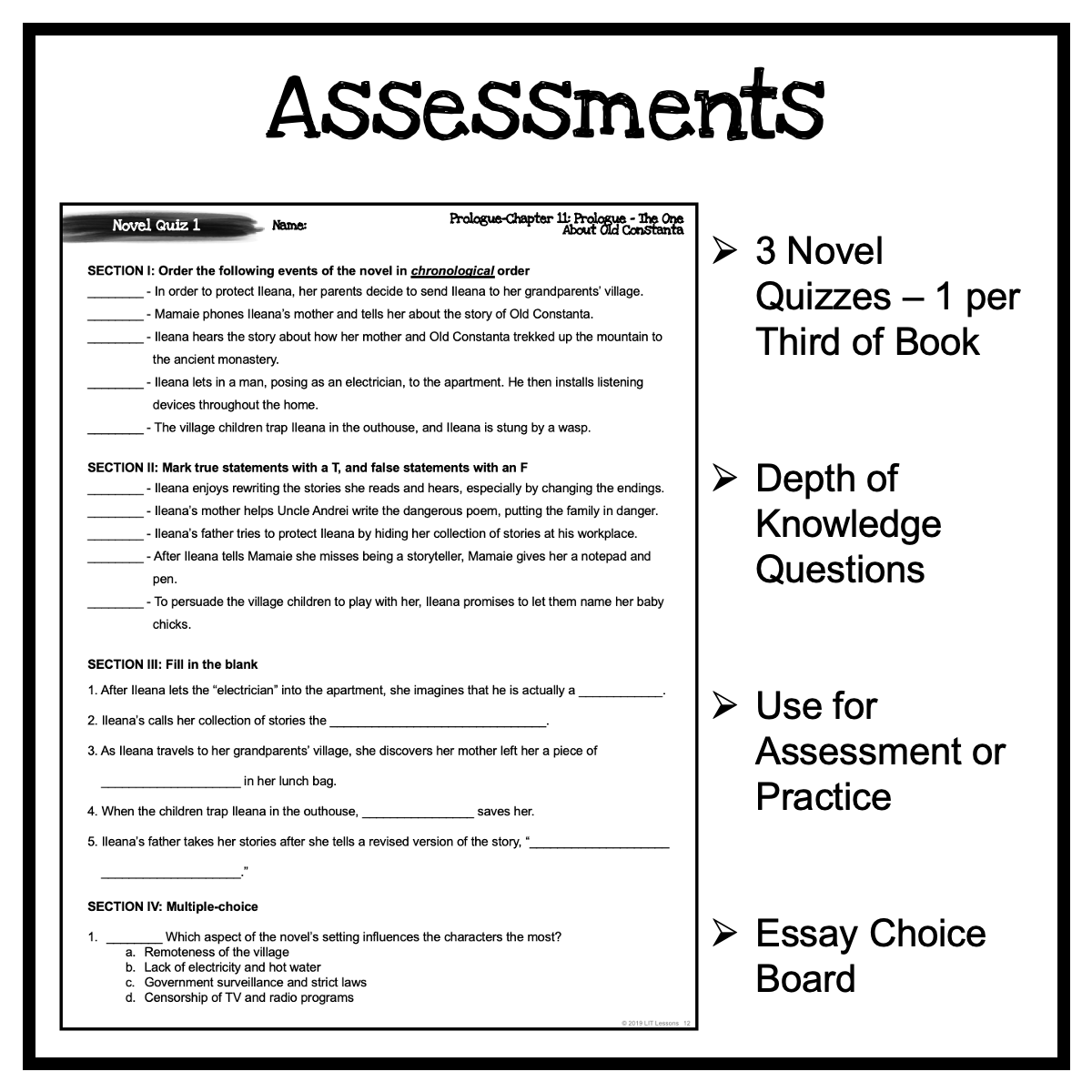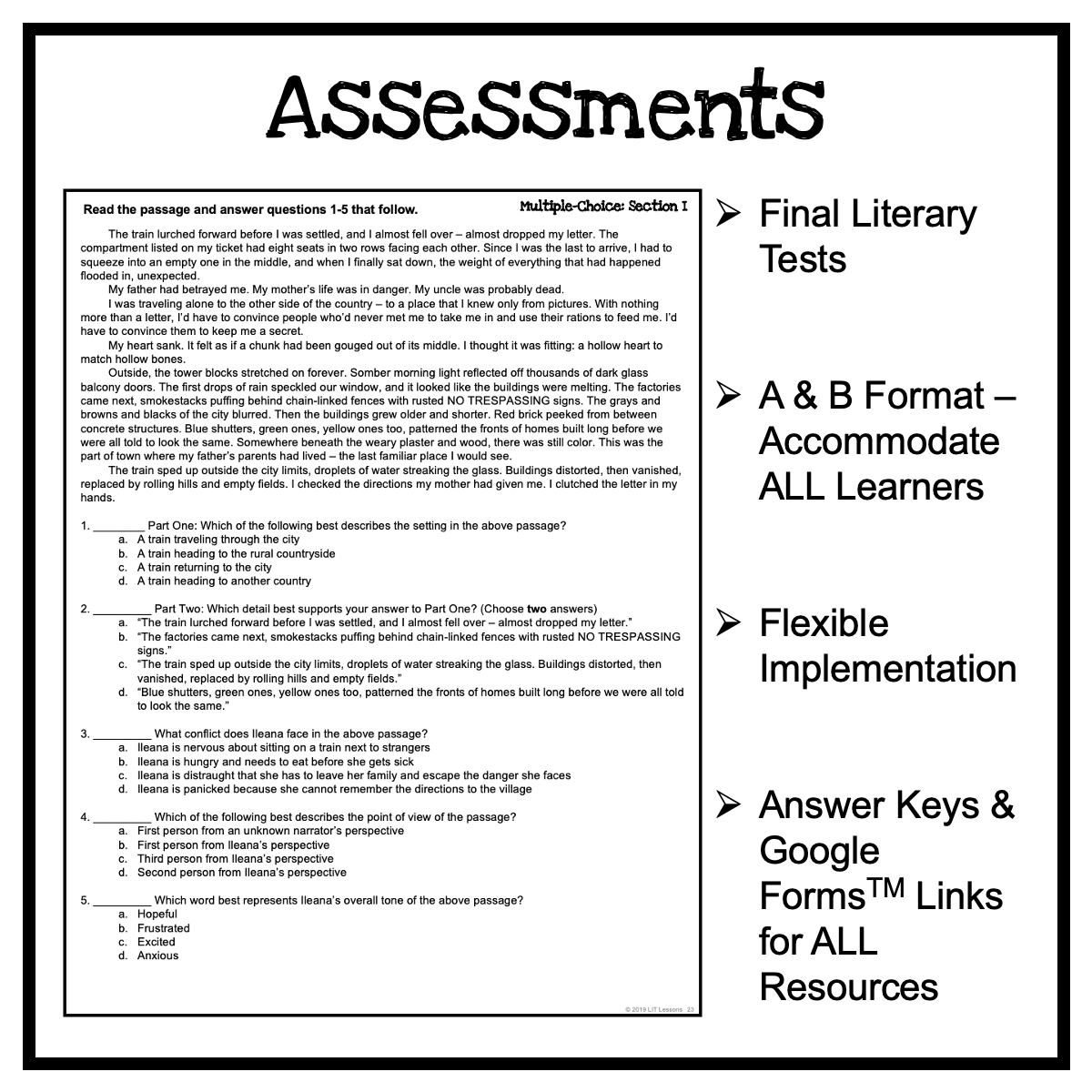The Story That Cannot Be Told Assessments
You can only add to a wishlist if you have an account, please register now.
Create an Account$7
The Story That Cannot Be Told Assessments – Snapshot of Included Resources:
- 24 Mini-Quizzes to Check for Understanding – 3 Questions per Quiz
- 3 Novel Quizzes – Each Third of Novel
- 2 Final Assessments to Accommodate for Learners (A & B)
- Creative Map Assessment
- Essay Choice Board – 5 Prompts
- Digital Links for Google Drive™
- Google Forms™
- Answer Keys
-
Chapter Set Mini-Quizzes: The 24 chapter mini-quizzes assess students’ understanding of each reading. Each quiz asks three questions related to the events of each chapter grouping. The quiz can be used at the end of class or if assigning reading for homework, can assess whether or not students did, in fact, complete their work. An answer key is included.
-
Comprehension and Literary Quizzes: The 3 comprehension and literary quizzes assess students on the events, characters, and details of the novel. For every twelve chapters of the novel, the quizzes include a variety of question types including: sequence of events, true/false, fill-in-the-blank, multiple-choice, and short answer questions. Answer keys for each quiz are included.
-
Final Tests: The two final tests asks students to apply the literacy skills they’ve developed over the course of the novel study. Each version assesses the same skills, but in different ways and at different levels of rigor. One assessment contains questions that emphasize comprehension abilities (Assessment A) while the other assessment contains questions that emphasize analytic abilities (Assessment B). Each question is aligned to a specific skill and, in turn, a specific Common Core State Standard. The first part of each test is a character quote matching section. The second part of each test contains 15 multiple choice questions, and the final part of each test asks 7 short answer questions requiring a written response. Answer keys are included.
-
Map Test: The map test provides a distinct format for assessing your students’ comprehension of the novel and their analytic abilities. In addition to understanding literary elements, the students are tasked with reading and utilizing a graphic, another important literacy skill.
-
Essay Choice Board: This resource contains 5 different essay questions. The questions are aligned to literary skills and are also Common Core aligned. Suggestions for answers/topics are included.
-
Final Reflection: On the last day of the unit, students can spend class time reflecting on their experience through the unit reflection questions. The reflection asks specific questions about individual experiences that can then serve as a way to guide future implementation of resources.
-
Exit Ticket Forms: The forms can serve as a small skills assessment at the end of each lesson. The ticket has room for a question-of-the-day as well as an effort rating.
- ZIP file (PDFs and Word Docs for Digital Links)
- Non-Editable
- 7.65 MB
- 47 Pages
- Links for Student Pages in Google Slides™ & Google Forms™
- This downloadable resource supplies one single-teacher license for use in your classroom.
- Photocopying of this product is allowed only for the classroom use of the purchaser.
- Replication of this product, in whole or in part, for commercial sale or broader distribution is strictly prohibited.
- This product also may NOT be shared electronically, digitally, or otherwise in a manner that violates the Terms of Use detailed by LIT Lessons.
- For explicit information on permissions, please see the Terms of Use document included with this resource. Thank you for your cooperation and understanding.
The Story That Cannot Be Told Assessments – Snapshot of Included Resources:
- 24 Mini-Quizzes to Check for Understanding – 3 Questions per Quiz
- 3 Novel Quizzes – Each Third of Novel
- 2 Final Assessments to Accommodate for Learners (A & B)
- Creative Map Assessment
- Essay Choice Board – 5 Prompts
- Digital Links for Google Drive™
- Google Forms™
- Answer Keys
-
Chapter Set Mini-Quizzes: The 24 chapter mini-quizzes assess students’ understanding of each reading. Each quiz asks three questions related to the events of each chapter grouping. The quiz can be used at the end of class or if assigning reading for homework, can assess whether or not students did, in fact, complete their work. An answer key is included.
-
Comprehension and Literary Quizzes: The 3 comprehension and literary quizzes assess students on the events, characters, and details of the novel. For every twelve chapters of the novel, the quizzes include a variety of question types including: sequence of events, true/false, fill-in-the-blank, multiple-choice, and short answer questions. Answer keys for each quiz are included.
-
Final Tests: The two final tests asks students to apply the literacy skills they’ve developed over the course of the novel study. Each version assesses the same skills, but in different ways and at different levels of rigor. One assessment contains questions that emphasize comprehension abilities (Assessment A) while the other assessment contains questions that emphasize analytic abilities (Assessment B). Each question is aligned to a specific skill and, in turn, a specific Common Core State Standard. The first part of each test is a character quote matching section. The second part of each test contains 15 multiple choice questions, and the final part of each test asks 7 short answer questions requiring a written response. Answer keys are included.
-
Map Test: The map test provides a distinct format for assessing your students’ comprehension of the novel and their analytic abilities. In addition to understanding literary elements, the students are tasked with reading and utilizing a graphic, another important literacy skill.
-
Essay Choice Board: This resource contains 5 different essay questions. The questions are aligned to literary skills and are also Common Core aligned. Suggestions for answers/topics are included.
-
Final Reflection: On the last day of the unit, students can spend class time reflecting on their experience through the unit reflection questions. The reflection asks specific questions about individual experiences that can then serve as a way to guide future implementation of resources.
-
Exit Ticket Forms: The forms can serve as a small skills assessment at the end of each lesson. The ticket has room for a question-of-the-day as well as an effort rating.
- ZIP file (PDFs and Word Docs for Digital Links)
- Non-Editable
- 7.65 MB
- 47 Pages
- Links for Student Pages in Google Slides™ & Google Forms™
- This downloadable resource supplies one single-teacher license for use in your classroom.
- Photocopying of this product is allowed only for the classroom use of the purchaser.
- Replication of this product, in whole or in part, for commercial sale or broader distribution is strictly prohibited.
- This product also may NOT be shared electronically, digitally, or otherwise in a manner that violates the Terms of Use detailed by LIT Lessons.
- For explicit information on permissions, please see the Terms of Use document included with this resource. Thank you for your cooperation and understanding.



More The Story That Cannot Be Told Resources...
The Story That Cannot Be Told Novel Study
The Story That Cannot Be Told Novel Study is a comprehensive set of standards-aligned instructional materials for teaching The Story That Cannot Be Told by J. Kasper Kramer. With over 100+ materials, students will deeply engage with the novel and develop their literacy skills. The close reading activities, literary analysis resources, Soviet Bloc nonfiction readings and activities, vocabulary, assessments, and final project options all provide opportunities for your students to practice and apply what will be their growing understanding of the novel. They also provide numerous ways for you to DIFFERENTIATE learning for your students, allowing you to choose the assignments that best support your students’ learning while being conducive to any classroom model.
The Story That Cannot Be Told Chapter Questions
The comprehension guide and literary analysis resources provide a framework for students to deeply engage with every chapter grouping of The Story That Cannot Be Told. The 48 assignments – 24 comprehension and 24 literary analysis – are designed to not only to have students practice essential literary skills but also demonstrate their comprehension of the text. In having students demonstrate their understanding of the novel across both dimensions, the resource allows for differentiation and flexible implementation.
The Story That Cannot Be Told Close Readings
The 24 close reading lessons explicitly focus on critical Common Core State Standards to develop students’ literacy proficiency. Using The Story That Cannot Be Told as the foundational text for close reading, each lesson focuses on a particular skill, such as setting, conflict, tone, and plot, and provides students an opportunity to develop and demonstrate their ability to perform that skill. Each assignment also requires students to use textual evidence to support their claims. The resources could supply homework, facilitate guided reading groups, or stimulate whole class literacy discussions for each chapter grouping. You can choose the purpose that best suits your students and your classroom.
The Story That Cannot Be Told History of the Soviet Bloc Nonfiction Readings & Activities
The 14 nonfiction close readings will build your students’ knowledge about the post-WWII period in history. With a particular focus on the Soviet Union and the Soviet Bloc, the readings illuminate the forces that contributed to deep tensions throughout the Cold War. Since The Story That Cannot Be Told is set in Romania, they focus on the Soviet Union and the Soviet Bloc in order to enhance your students’ understanding of the goals, principles, and tactics that shaped the story’s setting. Therefore, students will be able to synthesize across the nonfiction readings and the novel, building their critical thinking skills in the process. Students will learn about communism’s rise as a governing philosophy, the ways authoritarianism takes hold, and how ordinary people come to experience its effects. As they do, students will also practice key literacy skills aligned to the Common Core Standards, such as using textual evidence, identifying the author’s purpose, and making inferences, to name a few. By the time students finish reading, writing, and analyzing these materials, they will have grown in their ability to think critically, consider new perspectives, and carry with them a deeper understanding of history in the second half of the 20th century.
The Story That Cannot Be Told Vocabulary
The vocabulary resources will engage students in varied activities to expand their vocabulary. The resources include materials to help teach challenging vocabulary words in The Story That Cannot Be Told that will then build your students’ vocabulary. With 6 vocabulary lists of 10 words each and a crossword puzzle, practice assignment, and quiz for each set, the materials provide opportunities for differentiation to suit the needs of the classroom.

The Story That Cannot Be Told Novel Study
The Story That Cannot Be Told Novel Study is a comprehensive set of standards-aligned instructional materials for teaching The Story That Cannot Be Told by J. Kasper Kramer. With over 100+ materials, students will deeply engage with the novel and develop their literacy skills. The close reading activities, literary analysis resources, Soviet Bloc nonfiction readings and activities, vocabulary, assessments, and final project options all provide opportunities for your students to practice and apply what will be their growing understanding of the novel. They also provide numerous ways for you to DIFFERENTIATE learning for your students, allowing you to choose the assignments that best support your students’ learning while being conducive to any classroom model.

The Story That Cannot Be Told Chapter Questions
The comprehension guide and literary analysis resources provide a framework for students to deeply engage with every chapter grouping of The Story That Cannot Be Told. The 48 assignments – 24 comprehension and 24 literary analysis – are designed to not only to have students practice essential literary skills but also demonstrate their comprehension of the text. In having students demonstrate their understanding of the novel across both dimensions, the resource allows for differentiation and flexible implementation.
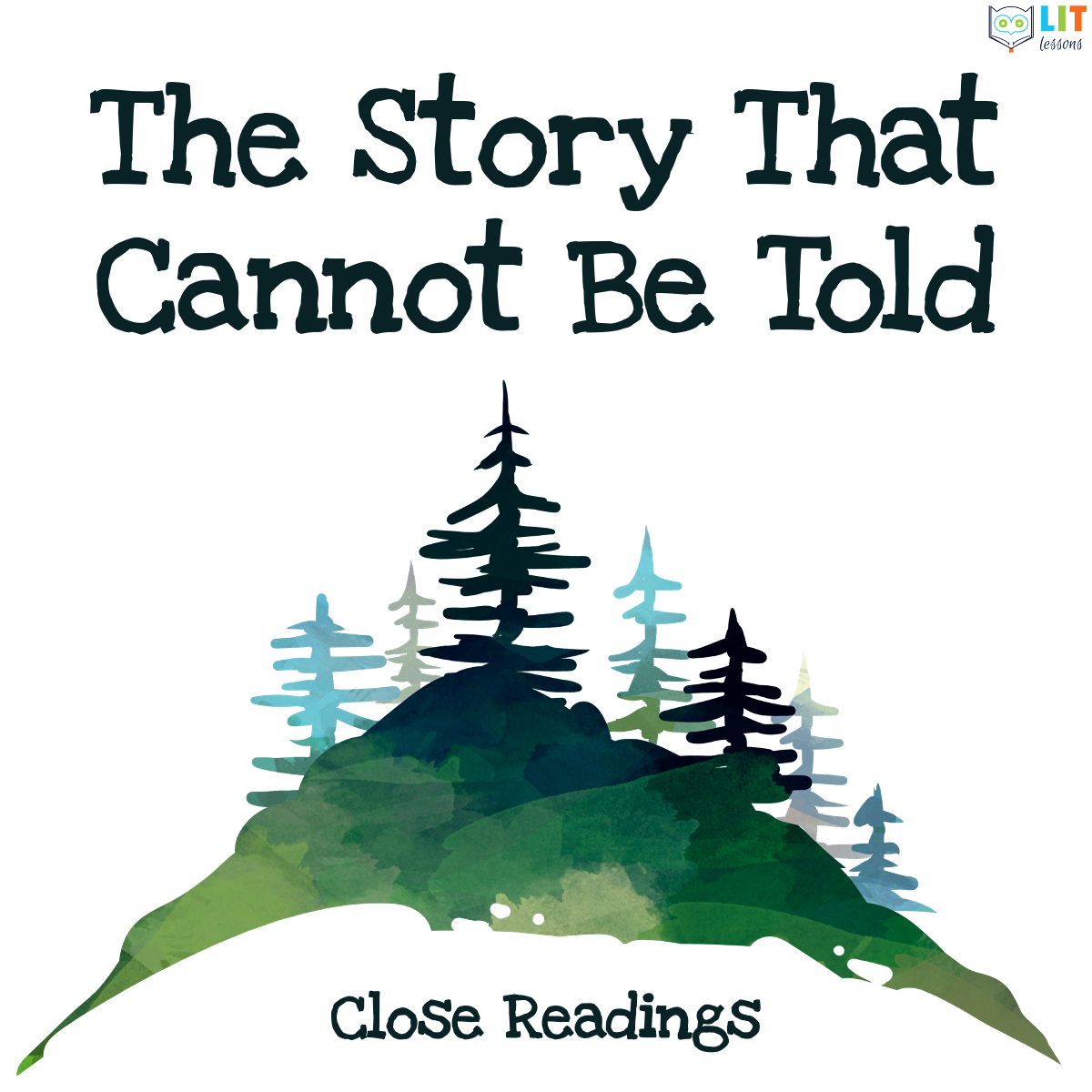
The Story That Cannot Be Told Close Readings
The 24 close reading lessons explicitly focus on critical Common Core State Standards to develop students’ literacy proficiency. Using The Story That Cannot Be Told as the foundational text for close reading, each lesson focuses on a particular skill, such as setting, conflict, tone, and plot, and provides students an opportunity to develop and demonstrate their ability to perform that skill. Each assignment also requires students to use textual evidence to support their claims. The resources could supply homework, facilitate guided reading groups, or stimulate whole class literacy discussions for each chapter grouping. You can choose the purpose that best suits your students and your classroom.
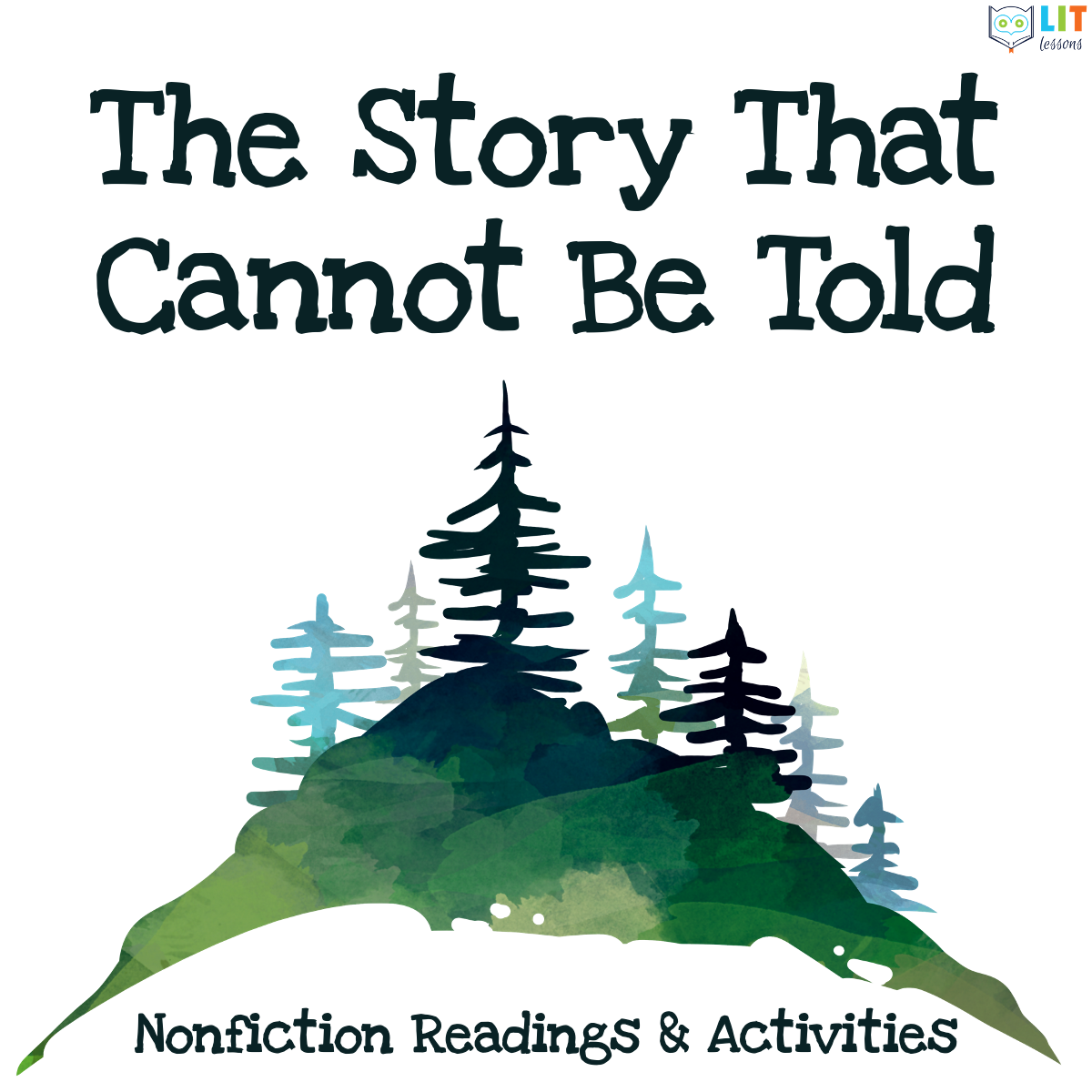
The Story That Cannot Be Told History of the Soviet Bloc Nonfiction Readings & Activities
The 14 nonfiction close readings will build your students’ knowledge about the post-WWII period in history. With a particular focus on the Soviet Union and the Soviet Bloc, the readings illuminate the forces that contributed to deep tensions throughout the Cold War. Since The Story That Cannot Be Told is set in Romania, they focus on the Soviet Union and the Soviet Bloc in order to enhance your students’ understanding of the goals, principles, and tactics that shaped the story’s setting. Therefore, students will be able to synthesize across the nonfiction readings and the novel, building their critical thinking skills in the process. Students will learn about communism’s rise as a governing philosophy, the ways authoritarianism takes hold, and how ordinary people come to experience its effects. As they do, students will also practice key literacy skills aligned to the Common Core Standards, such as using textual evidence, identifying the author’s purpose, and making inferences, to name a few. By the time students finish reading, writing, and analyzing these materials, they will have grown in their ability to think critically, consider new perspectives, and carry with them a deeper understanding of history in the second half of the 20th century.
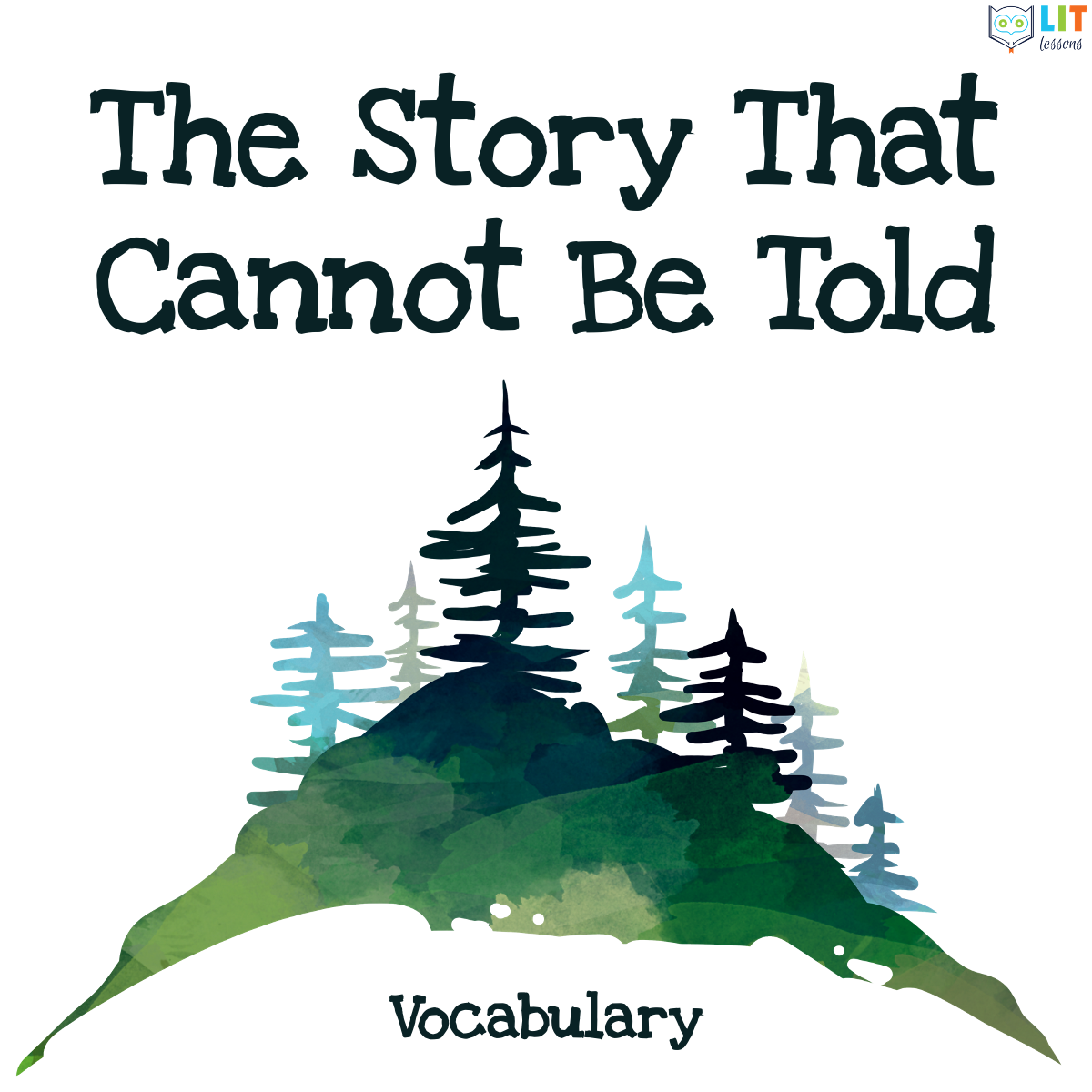
The Story That Cannot Be Told Vocabulary
The vocabulary resources will engage students in varied activities to expand their vocabulary. The resources include materials to help teach challenging vocabulary words in The Story That Cannot Be Told that will then build your students’ vocabulary. With 6 vocabulary lists of 10 words each and a crossword puzzle, practice assignment, and quiz for each set, the materials provide opportunities for differentiation to suit the needs of the classroom.

